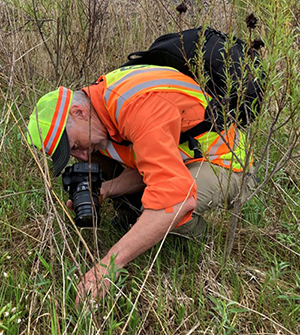By Joseph Palmersheim

Dave Hanson, a natural resource program coordinator with MnDOTís Roadside Vegetation Management Unit, photographs small white Lady Slipper flowers. The Lady Slipper was adopted as the state flower in 1902. Photo by Beth Brown
|
Dave Hanson is a natural resource program coordinator with MnDOT’s Roadside Vegetation Management Unit. Hanson, an 11-year MnDOT employee, said that another way to describe his job would be “roadside vegetation manager.” He maintains certification as an International Society of Arboriculture: Certified Arborist. He’s also a State of Minnesota Tree Inspector and is qualified by the DNR to conduct rare plant surveys.
What do you do in your job, and what do you find interesting about it?
RVMU team members are often referred to as “MnDOT’s foresters.” Forests, boulevard trees, or individual trees are often at the forefront of our conversations. There is so much more to experience on MnDOT’s roadsides. This includes grasses, wildflowers and many other plants supporting roadside habitats.
My time in the office can include working on vegetation reviews for early notification memos or permit requests. Deskwork may involve tree-related questions or questions about plant identification or weed control. My time in the field is often focused on trees in urban settings, like boulevards, and preservation or removal of a tree or trees.
The interesting part is that I get to spend time outdoors in Minnesota consorting with plants. Then, even though I am an introvert by nature, I enjoy the opportunities I am given to share my knowledge and experience with the MnDOT team statewide.
What sort of activities do you do in the field?
Tree surveys, including identification and mapping before rural or urban infrastructure improvements. Typically, the focus is on whether trees should stay or be removed. If they are to be retained, we determine whether they need protection from construction activities.
Minnesota’s roads travel through many distinct habitats, such as remnant prairies, forests or wetlands. These habitats may harbor state-listed threatened or endangered species. This is one instance where my plant identification skills are often brought to bear. If we find a unique habitat or a rare plant species, we begin the discussion with partners on how best to preserve or avoid that resource.
And on rare occasions, I get my hands dirty helping with prescribed fire operations.
What are some of the variables and challenges that come with working in the natural
world/outdoors?
Besides weather, insects and poison ivy?
People and passions. And, I would say rightly so. People are attached to nature and natural things in deep ways. It could be a clump of Showy Lady’s Slippers or hundreds of them. It could be a small patch of land or acres, an individual tree or a forest. But they form very real, emotional attachments. The emotions are difficult to express in words, but they show in the angst when change is imminent.
Unfortunately, when change happens it can be difficult to witness, and it can be emotional. It doesn’t matter if that change is from natural forces, such as wind or fire, or by human development. The challenge is softening or explaining that change. We balance the need for an alteration, maybe a safety improvement, with the preservation or, in some cases, removal of a natural entity.
How has your role changed since you started?
The role, for the most part, has remained unchanged. Fortunately, the activities that make up the role are many and varied. That variety keeps the work life challenging, interesting and fun.
One of the many rewarding MnDOT experiences has been putting my skills to work on an update to MnDOT’s Minnesota Noxious Weeds book. Since its completion in 2012, it has become a standard training manual for anyone working to manage noxious weeds in Minnesota, and many partner agencies use it.
The only change I will mention has been gradual, from MnDOT rookie to being one of the team leads. I enjoy bringing in new people and sharing my experience and knowledge with them to further their development and career at MnDOT.
What did you want to be when you were growing up, and what was your path to forestry/MnDOT?
That is a good question! I grew up in south central Minnesota and loved being outdoors. I think there were thoughts of pursuing a degree in biology and following some path to a job outdoors. But soon after entering college, I discovered computer science and I was hooked.
That put me on the journey that has not been without a few sharp turns. A degree in computer science and mathematics from Minnesota State University-Mankato turned into 18 years with Unisys Corporation, where I solved operating system software glitches. As that job wound down, I attended the University of Minnesota and earned a degree in assessment and modeling of natural resources, heavy on GIS.
My minor in forestry management became the catalyst for 10 years as a research specialist in Urban and Community Forestry. I continued taking classes and completed a master's degree focused on Urban and Community Forestry. Then, 11 years and 5 months ago, another turn in the path brought an opportunity to work with MnDOT, and here I am.
Do you or a co-worker have an interesting job to share with readers? Send us your ideas, and we’ll contact you for more information.
Recent employee profiles:
|



